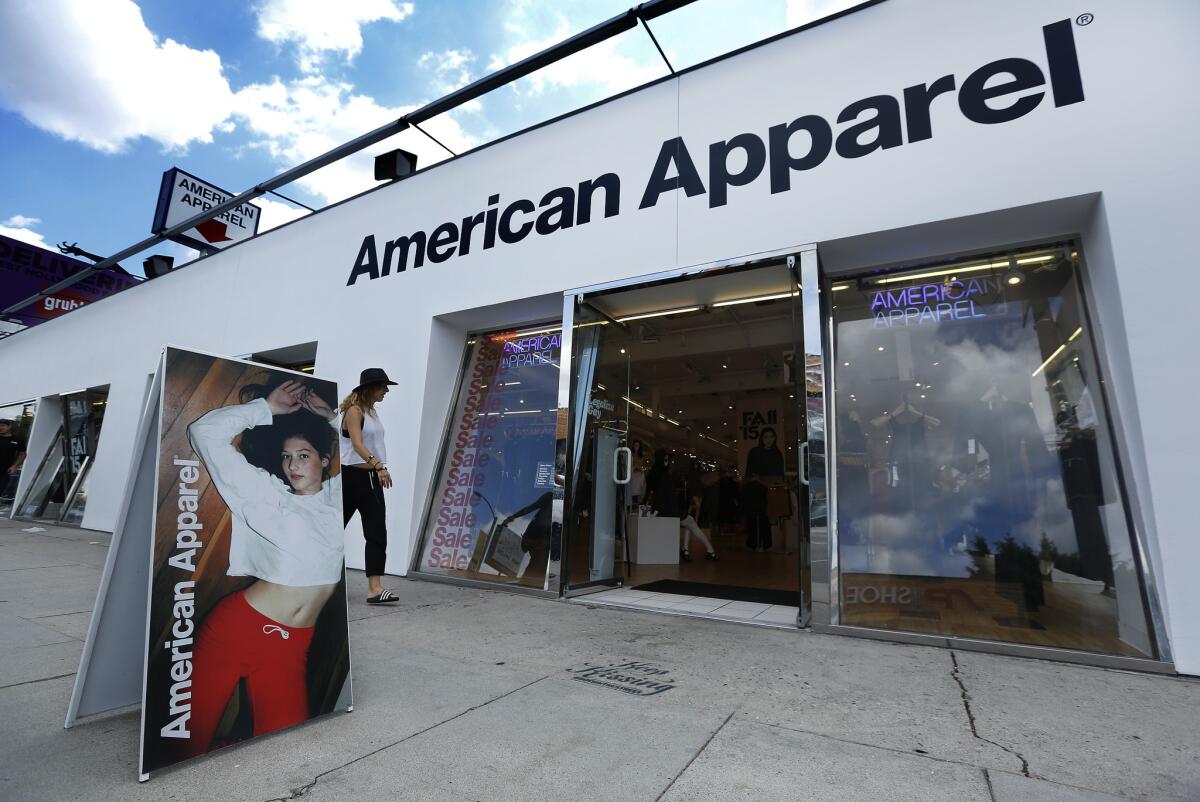Fashion brands — including several L.A. retailers — are dying off as shoppers’ habits change

- Share via
American Apparel bit the dust. So did Nasty Gal. BCBG Max Azria filed for bankruptcy, along with teen retailer Wet Seal.
The fashion industry has long been a fickle beast, with trends rising and dying sometimes in the space of weeks. But changing consumer habits — including the emergence of e-commerce and the decline of traffic at many malls — is further shortening the life cycle for many fashion brands, analysts said.
“Thirty years ago, you didn’t have to adapt as fast,” said Ron Friedman, a retail expert at accounting and advisory firm Marcum. “The retail environment is completely going through a revolution. Your normal brick-and-mortars are restructuring. Brands are going out of style.”
Faced with seismic changes, bankruptcies in the retail sector have been on the rise. In 2012, three retail companies with liabilities of $50 million or more filed for bankruptcy, according to a study by consulting firm AlixPartners. Eight retail bankruptcies occurred in 2014 — a number that had already been reached just six months into 2015, the last year analyzed in the study (although that still pales to 20 bankruptcies in 2008 during the height of the recession).
To be sure, once-hot brands faded away with nary a whimper before the digital age — Robert Hall in the 1970s, Rogers Peet in the 1980s and Merry-Go-Round in the 1990s. But the Web has been a double-edged sword for fashion brands, both a way to reach a worldwide audience for their wares, while also serving as a giant emporium where shoppers can click to a rival site in seconds.
“There’s a perfect storm now,” said Corali Lopez-Castro, a partner at Kozyak Tropin & Throckmorton who has handled retail bankruptcies. “I don’t know if many retailers can adjust.”
Some retailers have stumbled, including a number of Southern California brands. It’s a region that has already been hard-hit by a decline in garment manufacturing — and as home for many casual brands, is especially susceptible to the rise of fast fashion.
BCBG admits its failure to harness the Web contributed to its downfall. The Los Angeles company said e-commerce sales made up only “a small proportion” of its overall business, according to bankruptcy documents.
The rise of fast-fashion rivals has also shortened the attention span of consumers. Before H&M and Zara came on the scene, retailers that had a lackluster season could course-correct a few months down the line — knowing shoppers would likely come back to browse while strolling their local mall. But now shoppers can hop online or go to fast-fashion stores that introduce fresh fashions on a weekly basis.
“If you are a fashion apparel retailer, you have to have a steady flow of newness,” said Craig Johnson, president of Customer Growth Partners. “You can’t just regurgitate what was hot last year.”
At the same time, consumers are spending a diminishing chunk of their income on clothing, opting to shell out for electronics or experiences instead. Less than 4% of every dollar is now spent on buying apparel, Johnson said, compared to 8% in the mid-1990s and 20% a century ago.
The off-shoring of manufacturing has dramatically reduced the price of clothing over the last few decades. That has wounded brands catering to young shoppers. Irvine-based Wet Seal, for example, is preparing to close its stores after filing for bankruptcy for the second time in February.
Aside from premium denim, Southern California brands tend to offer more casual wear, compared to designer-heavy New York, Johnson said. Shoppers therefore find it easier to switch to buying via e-commerce sites such as Amazon or in fast-fashion stores — one reason so many local firms have faltered in recent years.
“There is virtually nothing that places like Wet Seal or American Apparel sell that you can’t get on the Internet for a lower price,” Johnson said. “There is nothing that distinguishes it.”
New fashion brands are also finding an increasingly tough climb. They can reach potential customers directly on social media and sell product from their own websites. But it requires heavy investment to get eyeballs — especially when companies are trying to attract investors by demonstrating fast growth, analysts said. Nasty Gal, a once-hot Los Angeles firm that sold its intellectual property for $20 million after filing for bankruptcy in November, saw its sales plunge after it ran out of money to invest in online marketing and advertising.
Friedman, who has consulted for fashion brands for decades, now tells new businesses that they need starting capital between $500,000 to a $1 million. That’s compared to $200,000 to $300,000 about a decade ago, he said.
“Before, you could go to Fred Segal and get your product on the floor, or go to Bloomingdale’s headquarters and get it on their floor,” Friedman said. “Today, you have got to go to the Internet and sell direct to consumers, and the cost can be very high.”
That cost means that fashion brands can burn through cash quickly, which can be a death knell for those without fresh investment or brisk sales.
After changes to the U.S. bankruptcy code in 2005, retailers that are forced to file for bankruptcy protection are also less likely to survive. Those changes shortened the time frame that retailers have to get approval for restructuring or a sale; companies only have 210 days to decide whether to hold onto or get rid of store leases.
Brick-and-mortar retailers, especially, have been hit hard. Instead of getting out of unprofitable leases and emerging from bankruptcy as a leaner business, many end up going out of business entirely and selling their brand.
That has led to an environment in which only the savviest company, especially those with physical stores, can survive.
“It’s the law of nature,” Johnson said. “Whether it’s an animal species or a retailer, the weakest players get winnowed out.”
Since 2005, 55% of retailers that have filed have ultimately liquidated their business, compared to 5% of bankruptcies in other industries, the AlixPartners survey said.
This year is expected to be another big year for bankruptcies.
“You’re going to see one every single month in 2017,” said Lopez-Castro. “Once you lose a customer, it’s very hard to get that customer back.”
Twitter: @ByShanLi
More to Read
Inside the business of entertainment
The Wide Shot brings you news, analysis and insights on everything from streaming wars to production — and what it all means for the future.
You may occasionally receive promotional content from the Los Angeles Times.











